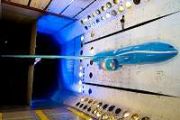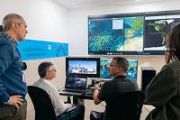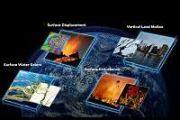
Copernical Team
Tracking satellites at the speed of light
2025 marks a landmark year for Europe’s ‘bridge between Earth and space’. The European Space Agency’s Estrack satellite tracking network turns 50.
Since its inception in 1975, Estrack – ESA’s global network of ground stations – has formed the vital communication bridge between satellites in orbit and mission control at the European Space Operations Centre (ESOC) in Darmstadt, Germany.
Now comprising six stations spanning six countries, Estrack has grown into a strategic asset for Europe, enabling communication with spacecraft, transmitting commands and receiving scientific data.
The network keeps an eye on satellites no matter their location: tracking them across Earth
The other space race: Why the world is obsessed with sending objects into orbit
This request seems a bit unusual, so we need to confirm that you're human. Please press and hold the button until it turns completely green. Thank you for your cooperation!
Press and hold the button
If you believe this is an error, please contact our support team.
185.132.36.159 : 6e4f2b02-31bc-4700-aa3d-ac30666a
Port Canaveral preps for more rocket recoveries with third crane
This request seems a bit unusual, so we need to confirm that you're human. Please press and hold the button until it turns completely green. Thank you for your cooperation!
Press and hold the button
If you believe this is an error, please contact our support team.
185.132.36.159 : 2d49e31d-7165-4081-8056-5cd74d41
Interstellar comet swinging past Mars as a fleet of spacecraft looks on
This request seems a bit unusual, so we need to confirm that you're human. Please press and hold the button until it turns completely green. Thank you for your cooperation!
Press and hold the button
If you believe this is an error, please contact our support team.
185.132.36.159 : 7e5460c5-2329-4fdb-8556-b8cb38f9
Galileo R&D tests new uplink antenna

Galileo relies on ground-based uplink stations (ULS) to maintain accurate positioning for users worldwide. These stations transmit essential data to the satellites, including the information required to compute the satellites' orbits and clock corrections. Traditionally, such messages are sent using dish antennas. However, a new type of ground uplink antenna – a phased array antenna – was recently tested at the European Space Agency’s (ESA) site in Redu, Belgium. Developed under ESA's Horizon 2020 programme for R&D, which aims to keep Galileo up to date with the latest innovations, this innovative antenna could benefit
Fly over Xanthe Terra with Mars Express
 Video:
00:03:16
Video:
00:03:16
ESA’s Mars Express takes us on another mesmerising flight over curving channels carved by water, islands that have resisted erosion, and a maze of hilly terrain.
Central to the tour is a 1300 km-long outflow channel called Shalbatana Vallis. It cascades down from the highland region of Xanthe Terra to the smoother lowlands of Chryse Planitia.
Billions of years ago, water surged through this channel, creating many of the features we see today.
The tour culminates in a spectacular view of a 100 km-wide impact crater, smashed out of Mars’s surface when it collided with a space rock.
Enjoy the flight, and be
Pulsar Fusion to Demonstrate Advanced Propulsion on Momentus Vigoride Mission
 Momentus Inc. has signed a contract to launch a demonstration mission for Pulsar Fusion's next-generation Hall Effect Thruster (HET) propulsion system. The U.S.-based satellite services provider will integrate Pulsar's technology aboard its Vigoride orbital service vehicle, with launch scheduled for late 2026.
The mission is designed to provide Pulsar with an in-orbit platform to validate
Momentus Inc. has signed a contract to launch a demonstration mission for Pulsar Fusion's next-generation Hall Effect Thruster (HET) propulsion system. The U.S.-based satellite services provider will integrate Pulsar's technology aboard its Vigoride orbital service vehicle, with launch scheduled for late 2026.
The mission is designed to provide Pulsar with an in-orbit platform to validate ESA and Avio advance design of reusable rocket upper stage
 ESA has signed a contract with Avio to develop a demonstration mission for a reusable rocket upper stage, marking a step toward fully reusable European launch systems. The program will define system requirements, explore disruptive solutions, and deliver preliminary designs for both flight and ground infrastructure.
The initiative builds on previous industrial work and aims to reduce risks
ESA has signed a contract with Avio to develop a demonstration mission for a reusable rocket upper stage, marking a step toward fully reusable European launch systems. The program will define system requirements, explore disruptive solutions, and deliver preliminary designs for both flight and ground infrastructure.
The initiative builds on previous industrial work and aims to reduce risks Out-of-this-world ice geysers on Saturn's Enceladus
 In the 17th century, astronomers Christiaan Huygens and Giovanni Cassini trained their telescopes on Saturn and uncovered a startling truth: the planet's luminous bands were not solid appendages, but vast, separate rings composed of countless nested arcs.
Centuries later, NASA's Cassini-Huygens (Cassini) probe carried the exploration of Saturn even further. Beginning in 2005, it sent back
In the 17th century, astronomers Christiaan Huygens and Giovanni Cassini trained their telescopes on Saturn and uncovered a startling truth: the planet's luminous bands were not solid appendages, but vast, separate rings composed of countless nested arcs.
Centuries later, NASA's Cassini-Huygens (Cassini) probe carried the exploration of Saturn even further. Beginning in 2005, it sent back Evidence of a past, deep ocean on Uranian moon, Ariel
 Growing evidence suggests that a subsurface ocean lurks beneath the icy surface of Uranus' moon Ariel, but new research, published in Icarus, characterizes the possible evolution of this ocean, and found that it may have once been over 100 miles (170 kilometers) deep. For perspective, the Pacific Ocean averages 2.5 miles (4 kilometers) deep.
"Ariel is pretty unique in terms of icy moons,"
Growing evidence suggests that a subsurface ocean lurks beneath the icy surface of Uranus' moon Ariel, but new research, published in Icarus, characterizes the possible evolution of this ocean, and found that it may have once been over 100 miles (170 kilometers) deep. For perspective, the Pacific Ocean averages 2.5 miles (4 kilometers) deep.
"Ariel is pretty unique in terms of icy moons," 



































